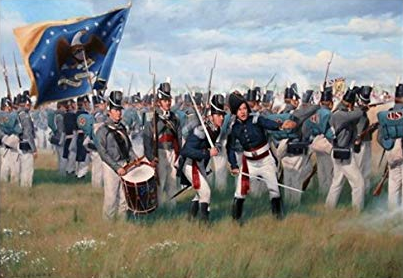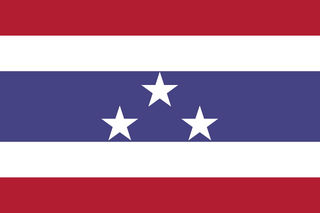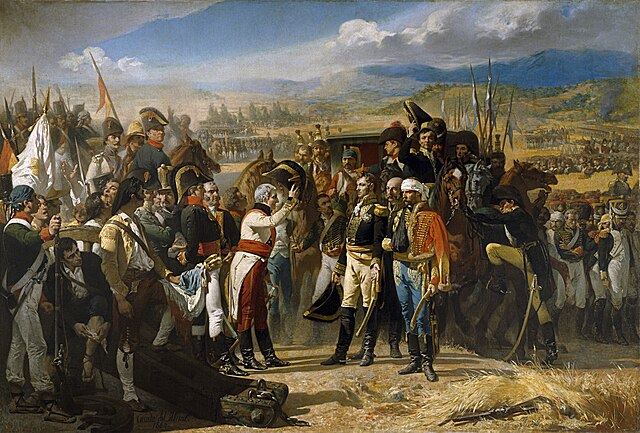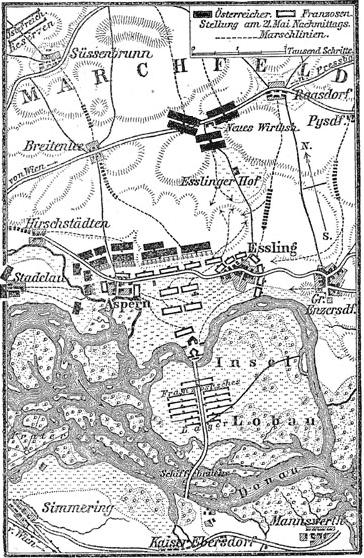Chapter 4: The War of the Fifth Coalition
"This Spanish ulcer is killing me and my empire"
-Napoleon Bonaparte
As Soult failed to conquer Galicia he decided to retreat to Astorga, leave a garrison through Leon and then turn west and attempt to push through the Douro, capture Porto and isolate Galicia, then besiege the Anglo-Spanish forces and hopefully seal the northern front. Soult's forces managed to sneak through the Douro while Moore was besieging Astorga and succesfully capture the city before being confronter by Silveira's and Wellesley's forces coming from the south, which handed Soult a dual defeat at Grijó and the second of Porto. Soult's forces were sent reeling across the border pursuited by the Anglo-Portuguese army, which he finally managed to stop at Ciudad Rodrigo while the Spanish to the south were reagroupping and finally stablishing a proper chain of command and General Staff; and in the east the cities of Saragossa (this one particularly brutal) and Gerona held continous attacks and sieges from the French, chomping away French manpower. Soult used this temporal pause through the spring to consolidate his positions and reorganise his forces, as more and more forces were called back from France to support the campaign against Austria and quell uprisings in Germany.
Napoleon was unsure of Austria's intentions after the news of the disaster at Spain spread, just in case, he began to reinforce Louis-Alexandre Berthier's army in southern Germany. When he was notified of the Austrian declaration of war he inmediately departed to France along with 30,000 troops from Spain, heading to the Rhine. Napoleon planned to knock out Austria quickly before the Russians (or the Prussians) could send forces, essentially repeating his glorious 1805 campaign. Austria attacked Bavaria and Italy on April 9th (a week before what Napoleon had predicted) and on the opposing side of the Danube, forcing Berthier's army to either cross the Danube or wait for the Austrians to do so, and risk Davout's forces on the other side. As the Austrians crossed the Isar river and captured Landshut by April 16th a rebellion broke out in Tyrol led by Andreas Hofer, who led a militia force through a spectacular victory at Bergisel that caught the Bavarian commanders off-guard and the French commander drunk [1], with both forces being captured with their equipment. Napoleon finally arrived at the battlefields by late April, crushing a small Austrian force at Abensberg just a day after the inconclusive battle of Teugen-Hausen. Napoleon then forced his pass through Landshut and pushed Austrian forces into Bohemia and the left bank of the Danube, securing victories at Eckmühl and Ebersberg, pushing into the Austrian heartland and capturing Vienna on May 13th. However, Austria's main fighting force under Archduke Charles was still mostly intact and just across the river waiting at the Marchfeld, being reinforced by a 30,000 strong Russian force under Prince Peter Wittgenstein [2]. Napoleon pushed for a crossing of the Danube using the island of Lobau as a stopgap. The subsequent battle of Aspern-Essling (sometimes known as the battle of Lobau) started when a French Army of 27,000 men crossed the Danube as the Austrians allowed them to do so, then firing their artillery and the french bridges, which lakced backing pales and collapsed, leaving the French forces trapped, but kept fighting as French artillery attempted to nullify their enemy's and cover the engineers' attempt at rebuilding the bridges. At 9 AM 22nd May the bridge was finished and the remaining French forces retreated, having lost most of their men and equipment. Further events in Germany would force Napoleon to abandon his Danube campaign and retreat out of fear of an encirclement.
Map depicting basic troop movements in the Battle of Aspern-Essling
The uprising of Spain gave wings to revolutionaries all across Europe, specially in Germany, with most of the country subjugated either directly (Confederation of the Rhine) or indirectly (Prussia) by France. A group of Prussian officers known as the "Tugendbund" (League of Virtue) was planning an uprising which had some degree of support from the government, specially from Heinrich Friedrich vom und zum Stein and Gerhard von Scharnhorst. Napoleon suspected that a conspiration could be boiling in Prussia but he couldn't find any proof of it [3]. The League of Virtue decided to wait until news from Russia and Austria arrived (Stein filtered them in secret meetings as he was pretty close to Frederick William himself). Finally, seeing that Napoleon was occupied in Bavaria, the Tugendbund launched his uprising against French forces in Prussia and Thuringia. On April 29th a force in Westphalia under Friedrich von Katte raised the banner of revolt and marched east to Magdeburg aided by the parallel uprisings of Wilhelm von Dörnberg at Kassel and Ferdinand von Schill at the Thuringia-Saxony border. Von Katte failed to storm Magdeburg but Schill's forces came to the rescue and secured a crossing of the Elbe while Dörnberg was causing mayhem in the French puppet of Westphalia. When news arrived of the succesful crossing of the Elbe, Scharnhorst launched a coup d'état in Berlin against the local French garrison. Frederick William suffered from indecisiveness (and even had a panic attack when hearing the news, fearing for Napoleon's response). He recomposed himself in time to see Scharnhorst's genius overrun the French garrison at Berlin. Knowing Russia was also at war with France and the revolt gathered local support, Friedrich William ordered the Prussian Army to arrest all French troops on Prussian soil and prepare for war. The French garrison at Kustrin, guarding the Oder was crushed by Scharnhorst's forces while the regiment at Breslau was informed of the uprising with time and managed to retreat all the way to Saxony. France and Prussia were now at war.
Prussian troops charge a French position
The Peninsular War reactivated when Wellington crossed into the Spanish highlands and faced the French at Talavera de la Reina, while the Spanish armies were amassing forces to push into Salamanca and Madrid from the south. The Battle of Talavera was a tactical victory for the Anglo-Spanish army as the French retreated, but Soult was marching to the south hoping to surround Wellesley's forces and cut his supply lines from Portugal. Wellesley decided to attempt to confront him [4] before he could cross the Tagus, parting with a force of 17,000 British soldiers that reinforced the Spanish forces at Puente del Arzobispo. The following battle over the Tagus met 37,000 French troops under Soult against 17,000 British troops under Wellington and 13,000 Spanish troops under De la Cuesta. The battle was brutal as the French chasseurs launched brutal cavalry charges that decimated the Spanish lines while the British held most of the French infantry. In the end the bridge was destroyed and the French, despite obtaining a victory, found themselves unable to take profit of it, with Joseph Bonaparte ordering Soult to return to Madrid and defend it from Spanish attacks coming from the north and south.
To the north, the forces of John Moore and La Romana, aided by 12,000 troops commanded by the Duke del Parque began to push into Castile from september, routing the forces of Jean Marchand near Salamanca and routed his VI corps. Marchand retreated south to Alba de Tormes, meeting with Kellerman's 10,000 troops only to be forced back again as the Duke del Parque surprised the French army with a prior crossing of the Tormes river. Kellerman requested further reinforcements from Madrid on november, but Joseph Bonaparte could spare little troops as the Coalition forces defeated Soult's army at Illescas [5]. Soult inflicted heavy casualties on a force twice his size, but by late November any hope of retaining Madrid was in vain. Joseph and his court left the city on December 2nd and an uprising opened the gates to Wellington's and De la Cuesta's forces. Kellerman and Marchand retreated towards Burgos, hoping to meet with what was left of Soult's forces and hold the line through the winter. After an entire year of opposing armies attempting to outmaneuver each other in the northern half of Spain, the war was static. During the capture of Madrid Spanish forces caught French soldiers with stolen art pieces from the El Pardo museum and the soldiers recovered them. After the war Spain's government asked for a retribution and they were handed back art pieces from the Louvre, including the
Mona Lisa.
The Iberian Campaign between late 1808 and 1809
With Prussia, Austria and Russia at war with France, Poland found itself completely surrounded. Despite Poniatowski's stand at Raszyn, he knew he couldn't stop the combined force that was about to enter Poland. Despite his forces outflanking the Austrians after Raszyn and capturing Krakow, his campaign was doomed the moment Russian forces crossed the Bug and Prussian forces secured Silesia, and German colonists living within Poland had also risen up. Poniatowski opted to attempt a last stand at Wodzislaw on May 2nd 1809. The end result was the almost complete anihilation of the Polish army and the death of Poniatowski when he launched a desperate cavalry charge against Austro-Russian lines. Polish independence was crushed again, but Poniatowski's last stand impressed the Russian tsar [6] and delayed the arrival of Russian forces to Germany two weeks. Brunswick, Osnabrück, Kassel and Minden had been taken by revolutionaries and French forces (read Saxon) under the then-ill Bernadotte marched west into Westphalia to curbstomp the uprising. Bernadotte pleaded to Napoleon to remove him from command due to his sickness, but the emperor refused and Bernadotte was sent to fight the rebels. He routed a mostly Westphalian force at the Battle of Eisenach of 28th July, securing the Hörsel river and then the Werra, where he had to stop as his sickness only got worse. He would later recover, but he would give a window of opportunity to the rebels, who called for Prussian help, which would arrive in September.
Meanwhile the army of Louis Claude Monnet, consisting mostly of ill-equipped Dutch recruits engaged von Dörnberg at Lübbecke, forcing him to retreat towards the Wiehen Hills, but had to abandon the pursuit of the rebels when Napoleon ordered him to return to the Netherlands and block a British landing in the Netherlands which had taken over the islands of Walcheren and South Beveland on July 30th, and they temporarily seized Antwerp before the sheer power of French artillery (and a myserious disease called "Antwerp fever [7]) forced them back to the island. Overall, the summer and autumn of 1809 was a confuse time for both sides, having to properly oil their war machines and knowing the opponent was well-prepared for a war, although with all of Europe assembled in a coalition against him, Napoleon knew he had to act fast before the enemy armies had time to reorganise and resupply. Thus, he began his offensive from Thuringia into the Saale, meeting a Prussian army under von Schill aided by two Russian regiments at the Battle of Naumburg. Napoleon decided to attack head-on during the morning of September 2nd, catching the Prussians with their left flank opened. French forces crossed the Saale with ease and routed Schill's army back to Berlin, where the offensive ran out of steam as French supplies reached a critical lowpoint, forcing Napoleon to retreat before capturing Berlin for the second time.
As the winter of 1809-1810 arrived, Napoleon realised he could lose the war despite his recent victory at Naumburg, and attempted to use diplomacy. He offered the Coalition a white peace in which he would retreat from Spain and fix the border between Napoleon and the Coalition at the border of the Confederation of the Rhine while sacrificing Polish and Saxon independence [8], but the Prussians would have none of it. Giving Napoleon time to rebuild his forces and rethink his strategy could lead to an even greater conflict in the future, and by 1809 the war had turned into a, as a British newspaper called it, "Crusade against Napoleon". Britain stablished a parallel Dutch administration at Walcheren, helping to contribute to an Anglo-Dutch reapprochement as locals assisted the Redcoats during the fever times, which had receded by winter. This infuriated Napoleon, who declared that his brother Louis was incapable of ruling and forced him to abdicate, incorporating the Netherlands into the French Empire. The Dutch attempted to revolt but were crushed even with British aid, although many had scaped to British South Beveland, increasing the concentration of people and causing a new fever outbreak in January 1810. Prussian, Russian and Austrian forces were assembling behind the Elbe, the Alps [9] and the Bohemian Mountains, waiting until the spring to attack. French forces in Germany were constantly harassed by rebels and their manpower was starting to feel the effects of an active war in three (four if counting the Netherlands) fronts at the same time.
Napoleon inspects his troops during the winter
Hostilities reactivated in the spring of 1810, as British and Swedish forces were beginning to show up in northern Germany (George III wanted to secure Hannover and considered Iberia a sidekick theater). Wellesley found himself depleted of British troops, having to compensate with Portuguese forces trained by Beresford into a competent fighting force, and Spanish recruits as their army structure was beginning to get back on it's feet. After the battles of Illescas and Alcañiz in Aragon French forces retreated behind the Ebro river. Anglo-Hispano-Portuguese forces routed Jourdan's army at Villanañe, opening the road to Vitoria and the Pyrenees. By July 1810 French forces had retreated behind the Pyrenees completely in the west, while Spanish forces aided by local militias resisted Suchet's attempts at clearing Catalonia of Spanish forces, then being recalled to France. By September, Spain was free of French presence. The drained French troops were moved to the Rhine Valley were Napoleon was preparing an offensive against the Coalition, hoping to knock Prussia out definetely. However, Coalition forces attacked before Napoleon could ultimate his plans, with the Austrians crossing into Bavaria from Bohemia and along the Danube, and a Prusso-Russian army advancing through the plains of northern Germany. Napoleon focused his defence on Thuringia and Westphalia, knowing his enemies would have to go through there eventually and prepared a trap for them. Austrian forces crossed into Italy led by Hohann von Hiller, facing the French of Eugène de Beauharnais at Venzone and succesfully crossed the Tagliamento river after Beauharnais ordered a retreat to the Piave river and then to the Brenta, where he finally stopped the Austrian onslaught until autumn.
The main attack came into Germany though, and Archduke Charles crushed a Bavarian garrison at Mühldorf. As the French army of Berthier retreated, Bavaria switched sides [10], crippling French supply routes into Germany and opening a hole in their defenses. This was followed shortly after by the defection of Saxony, which had been probing both sides for a favourable exit to the war. Napoleon ordered a general retreat towards the Weser and Rhine rivers in order to reorganise his forces, abandoning most of Germany to the Coalition, shortening supply lines and freeing troops from garrison and anti-guerrilla operations in Germany. The Austro-Bavarian army advanced into Franconia while the Russians were moving south from Magdeburg, defeating Berthier's army and sending forcing him to retreat behind the Vogelsberg range. Napoleon bid his time and waited until the Prussian and Russian forces were isolated enough to launch a counteroffensive, while the Coalition seemed to prefer a Fabian strategy. Napoleon was going to give them the exact opposite of that. Friedrich Wilehlm von Bülow's army was surprised when the French assaulted his position Schmallenberg, and without any other option but retreating to the north he did so. Napoleon then marched across this gap in the front to Bad Wieldungen, where he routed another Prussian force and crossed the Eder and recaptured Kassel. Coalition forces were slow to react and had to be moved from places as far away as Franconia to resist the attack, giving Napoleon enough time to consolidate his gains and for Ney's III corps to completely crush Bülow's remaining forces. Napoleon decided to press his attack further in a risky maneuver, finally encountering a massive coalition army of Swedes, Saxons, Prussians and Russians at Alberstedt.
The battlefield consisted of a lagoon to the north with a swampland just under it, with the Harz and Thuringian mountains to the North and South. Napoleon started the battle with an infantry charge at the farm of Schraplau and a detachment of forces crossed the small Welda river, with forces also occuppying Querfurt and the range to the south. Von Blücher ordered an assault to recover Schraplau but failed to do so as 300 French guns repelled the attack. The Coalition army outnumbered Napoleon by almost two to one, so Napoleon had to play the right cards in order to defeat them. He attempted to lure the main enemy force through the plains between the swamplands of the Süsser lake and the hills, succeeding in dragging Russia's corps under von Bennigsen, and then he launched a counterattack that sent the Russians reeling. Napoleon felt that it was time to crush the Russian forces using his cavalry, that slammed the Russian right flank. Then the Coalition artillery fired. The Coalition had almost 1,200 cannons in the battlefield, way more than the Emperor had predicted, and the cavalry charge was forced to stop only to be pusued by Austrian and Russian hussars that pressed the French chasseurs into the swamplands, bogging them down enough to catch them. French infantry attempted to attack under slight artillery cover (the rest was dueling the Coalition), being repelled. Then a massive Coalition charge was ordered, and with both the French artillery and cavalry occupied, French infantry was overrun. Napoleon retreated as the Old Guard and what remained of the Polish forces loyal to him launched a suicide charge in order to cover his retreat. The battle was a disaster for Napoleon, losing over 30,000 men and 40,000 prisoners, losses that completely crippled his army in Germany [11]. The Confederation of the Rhine vanished after the battle and the Coalition forces rushed to the Rhine, pursuiting Napoleon. Unadvertedly, Karl Philipp von Wrede's Austro-Bavarian army had placed itself behind the French to the south, hoping to cut Napoleon's supply lines and casually encountered Napoleon's remaining forces at Alsfeld, where Napoleon was defeated yet again by continuous cavalry charges that decimated his rearguard as he retreated across the Rhine, and even got hurt by a stray bullet in the armpit.
By autumn 1810, the French Empire was a walking corpse, running dry on troops and supplies, with foreign enemies about to enter France proper and internal tensions resurging as the confidence in the Emperor waned. Secred societies of radical republicans and absolutists were beginning to form all across France, with the local garrisons having difficulties to dismantle them. Napoleon liberated Ferdinand of Spain from his prison-palace at Valençay with hopes that this would lead to an arminstice in the Pyrenees [12]. Napoleon didn't get an arminstice, but the Spanish had to accomodate to the monarch, leaving Wellesley's forces temporarily alone, albeit he continued to push into France aided by the Portuguese. In Italy, Beauharnais' defences finally cracked in October and the Austrians swept most of Italy as the French retreated to the Alps and the local Italian troops found themselves outmatched and outgunned, surrendering quickly. Coalition forces crossed the Rhine at Neuwied on November 17th, repelling the French forces in the area. Napoleon won a delay victory at Gillenferd, but that was to be his last victory. While riding a carriage in Paris, a group of radical Republicans threw a bomb at his carriage, killing Napoleon instantly along with his spouse Josephine [13]. The radicals then proclaimed a "Second French Republic" in Paris, only to be curbstomped by Prince Bagration's forces twelve days later. Napoleon was dead, and the Napoleonic wars were over.
[1] - The commander being Pierre-Baptiste-François Bisson.
[2] - Russian detachments are small as they are still fighting the Ottomans for control of Bessarabia, but the war is mostly decided at this point and the Treaty of Bucharest is pretty much the same as IOTL.
[3] - Stein's letter is never intercepted ITTL. Also Napoleon is a bit more lenient to Prussia aswell, check previous chapter.
[4] - IOTL Spanish guerrillas intercepted a letter from Soult indicating that his army was twice as big as the British expected, this led to Wellington rethinking his strategy and retreating back to Portugal, waiting there for over a year.
[5] - TTL's equivalent to the Battle of Ocaña, except the French lose.
[6] - This will matter in a couple of years.
[7] - OTL Walcheren fever, likely a combination of malaria and typhus.
[8] - News of this were leaked to Frederick Augustus of Saxony, leading to his latter defection from the French cause.
[9] - The Austrians were defeated in Italy like IOTL.
[10] - Pretty much the OTL Treaty of Ried.
[11] - TTL's Battle of Leipzig.
[12] - He mentioned to his assistants that he regretted "not getting rid of this idiotic prince before".
[13] - Keenly pointed by a user, if the War of the Fifth Coalition doesn't end as IOTL Napoleon does not divorce Josephine and never marries Marie Louise.










